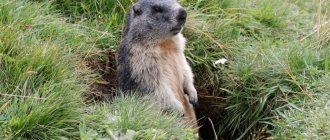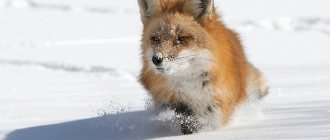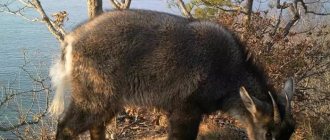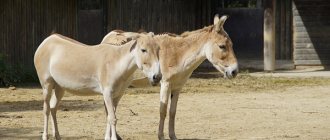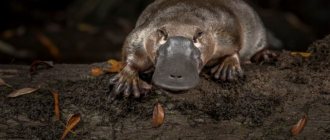The shrew is a fairly small animal belonging to the shrew family. This insectivore lives on almost all continents (except the northern ones), preferring to choose forest zones and tundra as its habitat. It is among the shrews that one can find the smallest and most voracious mammals - there are about 7 dozen species in this genus - almost two dozen of them live in Russia.
Description of the shrew
Externally, shrews resemble mice. The length of their elongated body is 6-8 cm, weight is about 8-15 g, the tail is relatively long from 3 to 5 cm. The head is a cone-shaped head, ending with a thin long movable proboscis, the teeth are brown or reddish. On the sides and back the fur is thick, velvety, brownish or dark brown in color, the belly is light gray. The ears look like small flaps that protrude slightly above the fur.
Feeding characteristics of shrews
— Advertising —
Shrews are carnivorous mammals. They spend almost all their time searching for food. They cannot live even three hours without food. This is due to intense metabolism and rapid digestion of food.
The shrew's diet includes earthworms, insect larvae and pupae, butterflies, and dragonflies. In addition, it also hunts animals such as mouse-like rodents and frogs. In winter, the food is monotonous, since under the snow in the unfrozen soil layer the shrew can only find wintering insects. Once in cellars and pantries, the shrew never touches food supplies; it only looks for insects.
Plant food can serve as a supplement to the shrew's main diet, especially in winter, for example, seeds of spruce and pine cones, linden nuts.
What does it eat?
In searching for food, the shrew is helped by a highly developed sense of smell and very sensitive hearing (even with the use of echolocation). The basis of her diet is animal food - this is understandable, because such proteins are the most high-calorie. The shrew feeds on everything it can catch with its needle-sharp teeth. Moreover, the amount of food that a shrew consumes per day can be several times greater than the entire animal itself.
A shrew (for example, its species is the tiny shrew) can feed an insane number of times throughout the day - more than a hundred - while eating every half hour.
Shrew distribution
The shrew is found throughout Eurasia from the shores of the Pacific to the Atlantic Ocean, south to Palestine and to Siberia in the north.
— Advertising —
The animal lives in various areas, but always in damp and shady areas. Lives in forests, parks, meadows. In cold seasons, it enters populated areas and hides in storerooms and cellars.
Habitat
Giant shrews prefer to settle in wooded areas filled with coniferous and broad-leaved trees. Such animals dig holes on slopes that are in close proximity to water sources. In particular, these animals build their homes in river valleys. In general, shrews try to stick to damp, but not swampy areas.
Currently, the most numerous populations are observed in the southern part of Primorsky Krai. Giant shrews are found in areas located between the valleys of the Kamenka and Serebryanka rivers. Outside the domestic latitudes, representatives of the species were repeatedly caught in China and Korea.
Common types of shrews
- Common shrew or common shrew or wood shrew (Sorex araneus)
Body length 55-82 mm, weight from 4 to 16 g. Tail 60-75 mm long.
The body is dark brown on top, almost black-brown, the abdomen is light. The young are light brown. The tail is bare or slightly pubescent. The ears are almost invisible. The muzzle is narrow, elongated. The species is distributed in northern Europe in dense grassy thickets, forest undergrowth, bush thickets, and heather heaths.
- Tiny shrew or Chersky's shrew (Sorex minutissimus)
The smallest species with a body length of 4-5 cm, a tail length of 2.5-3 cm. Weight is about 4 g. The head is wide and large, ending with a short proboscis.
The eyes and ears are small. The fur is short, velvety, dark brown or brown on the back and gray or silvery-white on the belly. The tail is also dark above and light below. The species is found in the west from the Scandinavian Peninsula to Japan and Sakhalin in the east.
- Tibetan shrew (Sorex thibetanus)
The body length is 51-64 mm, the tail is 32-54 mm long. Outwardly similar to an ordinary shrew.
The species was discovered in China, in the provinces of Qinghai, Sichuan and Gansu.
- Bukhara shrew (Sorex buchariensis)
Body length 55-69 mm. The tail is 42-50 mm long with a tassel at the tip. The back is painted sandy brown or light brown. The belly is light gray. The head is elongated and narrow.
The species' habitat includes Uzbekistan, Tajikistan, and Kyrgyzstan, where it lives in high-mountain birch and poplar forests.
- Medium shrew (Sorex caecutiens)
Body length is from 58 to 77 mm, tail length is 36-42 mm, weight is 4-8.5 g. The back and sides are brown to dark gray, the belly is grayish-white.
Distributed from Finland, northern Sweden and Norway to the Anadyr River basin. Also found on Sakhalin (Russia) and Hokkaido (Japan), in Korea.
- Gansu shrew (Sorex cansulus)
Body length 62-64 mm, tail 38-43 mm long. The back is grayish-brown, the belly is reddish-fawn. The tail is dark brown above, light below.
A rare species that lives in the south of the Chinese province of Gansu.
Large-toothed shrew or dark-toothed shrew or dark-toothed shrew or dark-toothed shrew or large-toothed shrew (Sorex daphaenodon)
Body length is 61-71 mm, weight reaches 9.5 g. The proboscis is short. The back is dark brown or black, the sides are light, and the belly is dark gray. The tail is brown.
Distributed from the Urals to Sakhalin.
- Giant shrew (Sorex mirabilis)
One of the largest species with a body length of up to 10 cm and a weight of about 14 g. The body is brownish-brown in color, the belly is lighter and dull.
Muzzle with long light gray whiskers. Endemic to the Far East, where it lives in the south of the Primorsky Territory, northeast China and the north of the Korean Peninsula. Listed in the Red Book of Russia.
- Equal-toothed shrew (Sorex isodon)
Body size is average. The fur color is dark, monochromatic, the fifth upper intermediate tooth is brightly pigmented.
It is found in the taiga of Eurasia from the Scandinavian Peninsula and Belarus to the Pacific coast. Included in the Red Books of the Republic of Karelia and the Moscow Region.
- Kozlov's shrew or Tibetan mountain shrew (Sorex kozlovi)
Body length is about 41 mm, tail length up to 33 mm. Summer fur is long, fluffy, silky. The tail is pubescent with a tassel at the tip. The back is chocolate-brown in color, the sides are light, the belly is white with a fawn coating.
A rare species, was discovered in Tibet.
- Little shrew or small shrew or little shrew (Sorex minutus)
Body length 43-64 mm, tail length 31-46 mm.
Weight from 2.5 to 7.5 g. The back is brown-gray or reddish-coffee. The belly is grayish-white, rarely yellowish-fawn. Winter fur is darker. The hair on the tail is thick and long. The proboscis is sharp, elongated. Distributed in Europe, the European part of Russia, in the west and south of Siberia, in Kyrgyzstan.
- Clawed shrew (Sorex unguiculatus)
Outwardly it resembles a common shrew.
Body weight reaches 20 g, body length 54-97 mm, tail length 40-53 mm. Lives in China, Japan, Russia.
- Kamchatka shrew (Sorex camtschatica)
Body length is about 57 mm, tail 54 mm long.
Weight about 5 g. The back is earthy-gray, the sides are light, brown or fawn. The belly is light gray. The hind foot is very elongated. The species is distributed in the northeast of Siberia, in Kamchatka.
- Masked shrew (Sorex cinereus)
The body length reaches 9 cm, including 4 cm of tail length, weight up to 5 g. The fur is gray-brown on top, light gray below, the muzzle is pointed. The tail is brown above, lighter below, and the tip is dark.
Found in Canada and the USA.
- Long-tailed shrew (Sorex dispar)
The medium-sized shrew is gray in color with a light belly, a pointed muzzle and a long tail.
It lives in North America, in the forests of Canada and the USA.
- Little shrew (Sorex hoyi)
Body length is up to 5 cm, tail is about 2 cm, weight is 2-2.5 g. The fur is gray-brown or red-brown, the belly is light.
In winter, the fur turns gray. This is the smallest mammal in North America, lives in Canada and the USA, in coniferous and deciduous forests.
- Paramushir or Beringian shrew (Sorex leucogaster)
Outwardly it resembles an ordinary shrew.
It is endemic to Paramushir Island (Kuril Islands).
- Marsh shrew or water shrew (Sorex palustris)
Body length up to 15 cm, tail length about 8 cm, weight up to 13 g. The back is dark gray, the belly is light.
Found in Canada and the USA.
Why was the giant shrew included in the Red Book?
The reason for this is the constant decline in the number of the species. Over the past few centuries, the number of such rodents has decreased to critical levels. The animal was on the verge of extinction. The determining factor here was unwise human economic activity, in particular, the uncontrolled cutting down of broad-leaved and cedar trees, in the roots of which shrews find refuge.
Currently, the animal is under protection; it is listed in the Red Book of Russia. The giant shrew can be seen on the territory of such reserves as Kedrovaya Pad, Lazovsky, Sikhote-Alinsky and Ussuriysky. For the purpose of studying the species, a total of 42 adult individuals were captured here over the entire period. At the moment, the exact number of giant shrews in protected areas is not known. According to the researchers, the number of these relict rodents remains low and fluctuates enormously from year to year.
Shrew behavior
Shrews are very energetic animals and are nocturnal. During the day they search for food only near shelters. They hunt on the ground, sometimes climbing out onto low-growing grasses and shrubs. They move very quickly, jump 10-15 cm. They do not hibernate, and in winter they continue to actively search for food. At this time they live in deep drifts.
Reproduction of shrews
Shrews build nests in the top layer of soil, stumps or old burrows of other species from dry parts of herbaceous plants, and line them with moss on the inside.
The breeding season begins at the end of March and continues throughout the warm season. Females produce 2-3 broods, 7-8 babies in each. Pregnancy lasts 18-28 days. Shrews are born helpless, naked, blind, but they grow quickly and already at the age of 1 month they feed like adults.
Life expectancy is about 1.5 years.
Habitat and reproduction
The main areas of residence of the shrew include the northern parts of Asia and America, and the European part. The shrew is a type of shrew that adapts to life in any conditions: from forest to tundra, from river floodplains to semi-deserts.
This cute creature is also widespread in Russia, throughout the entire area of the country: from Moscow to Sakhalin. Those 15 species that live in their native Fatherland are barely distinguishable to the eyes of a non-professional naturalist. The main differences are the features of small parts of the body and genitals.
In taiga areas, the number of rodents is greater - 200-600 animals per 1 hectare of forest. There are much fewer tundra inhabitants, approximately 40-150 individuals for the same area. It makes spherical nest boxes using the stems of available plants, and hides them under tree rhizomes, stumps, and snags.
The shrew lives 12-18 months. breeds in the second year of life, immediately after the end of winter. Pregnancy is short - 2.5-3 weeks. The offspring leaves their father's house 3 weeks after birth. Some individuals manage to make three litters per season, with each subsequent number of cubs decreasing. If in the first there are up to 10 of them, then in the latter there are already 3-4.
Natural enemies of shrews
Many predators hunt shrews, but they do not always eat them, and often throw them away after being caught. This is due to the fact that the animal has specific glands that secrete a liquid with an unpleasant odor, which repels predators. The main natural enemy of the shrew is the owl.






